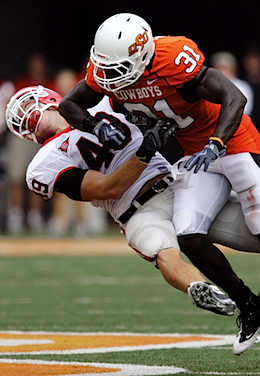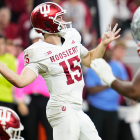NCAA rule proposes automatic ejection for 'targeting' penalties
The penalty, if approved by the Playing Rules Oversight Panel, will be a 15-yard penalty and automatic ejection of the player.

Florida's Matt Elam separates Louisville's Jeremy Wright from his helmet in January's Sugar Bowl. (AP)
Few terms in football have been more divisive over the past five years than "defenseless" -- as in a "defenseless" wide receiver in the act of catching a pass, where it's most commonly applied -- in part because it's served as the basis for a new class of penalties that did not exist before, and in part because that basis is so murky. From the point of view of the defender, whose job is to put opposing receivers on the ground by any means necessary, the concept can seem maddeningly arbitrary: When is a big hit legal, and when is it not? And how can a player with the ball in his hands, who is eligible by definition to be hit, ever be "defenseless" to begin with?
The NCAA hasn't done much to answer those questions, and didn't take any apparent steps toward clarity this week during the annual meeting of the Football Rules Committee. The committee did, however, move to strengthen the penalties associated with "targeting," approving a proposed rule that would impose an automatic ejection for "players who target and contact defenseless players above the shoulders," with the explicit goal of changing tackling techniques that lead to concussions and other head and neck injuries.
From the official NCAA release:
The committee, which met Monday-Wednesday, unanimously voted to increase the on-field penalty for targeting. The penalty, if approved by the Playing Rules Oversight Panel, will be a 15-yard penalty and automatic ejection of the player. The Panel meets on March 6 to review the proposals and membership comment.
[…]
The action by the committee continues a progression to address dangerous contact through its rules. Targeting, which was initially approved by the committee as a separate foul in 2008, has been generally successful in terms of officiating application, which made the committee feel comfortable in adding to the penalty.
"The general consensus is that the officials on the field make this call properly the vast majority of the time and know what the committee is looking for with this foul," said Rogers Redding, secretary-editor of the rules committee and national coordinator of officials for College Football Officiating, LLC. "This move is being made to directly change player behavior and impact player safety."
 Automatic ejections proposed. (US Presswire) |
The proposal is modeled on the current rule for fighting, which calls for a player who is ejected in the second half of a game to sit out the remainder of that game and the first half of the following game, as well. In the name of consistency, the rule (if approved) will allow for the ejection -- though not the penalty itself -- to be subject to review by instant replay, although "the replay official must have conclusive evidence that a player should not be ejected to overturn the call on the field." The release does not specify when the new rule would go into effect.
The rule also allows for individual conferences to impose their own penalties for targeting and helmet-to-helmet contact, including suspensions, which they have not been hesitant to invoke since head injuries began to emerge as an issue for major reform. In practice, though, those decisions have come in for repeated criticism over their perceived inconsistency, and flags applied to split-second hits on the field have been even less predictable. The first time a starter is forced to the bench by a judgement call over the exact nature and location of a collision, one that is only partly within his control, will be an open invitation to a firestorm.
Other proposed rule changes on their way for final approval would:
• Add a 10-second runoff with less than a minute remaining in either half when the sole reason for the clock to stop is an injury.
• Establish three seconds as the minimum amount of time required to be on the game clock in order to spike the ball to stop the clock. If one or two seconds remain on the clock, there is only time for the offense to run one more play.
• Require a player that changes numbers during the game to report this to the referee, who will announce this.
• Only allow one player number to be worn by the same team and participate at the same position (e.g., two quarterbacks on the same team are not allowed to have the same number).
• Require teams to have either their jersey or pants contrast in color to the playing field.
• Allow the use of electronic communication by the on-field officiating crew after successful experimentation by the Southeastern Conference. This is not a required piece of equipment but will allow officiating crews to use this tool.
• Allow the Big 12 Conference to experiment with using an eighth official on the field in conference games. This official would be placed in the backfield opposite the referee.
• Allow instant replay to adjust the clock at the end of each quarter. Previously this provision was only in place for the end of each half.
















